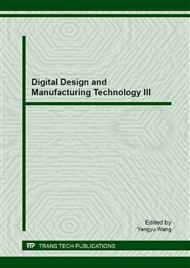[1]
Yi B L . Fuel cell: Principle, Technique and Application. Beijing: Chem. Indu. Press, (2003).
Google Scholar
[2]
Colleen S. Spiegel. Designing and Building Fuel Cells. The McGraw-Hill Companies, Inc. (2007).
Google Scholar
[3]
Liu, Y. and L. Hua. Fabrication of metallic bipolar plate for proton exchange membrane fuel cells by rubber pad forming. Journal of Power Sources 195(11): 3529-3535.
DOI: 10.1016/j.jpowsour.2009.12.046
Google Scholar
[4]
Middelman E, Kout W, Vogelaar B, et al. Bipolar Plates for PEM Fuel Cells[J]. Journal of Power Sources, 2003, 118(1-2): 44-46.
DOI: 10.1016/s0378-7753(03)00070-3
Google Scholar
[5]
K.S. Jeong, B.S. Oh, Fuel economy and life-cycle cost analysis of a fuel cell hybrid vehicle, J. Power Sources 105 (2002) 58–. 65.
DOI: 10.1016/s0378-7753(01)00965-x
Google Scholar
[6]
Tsuchiya H, Kobayashi O. Mass production cost of PEM fuel cell by learning curve. Int J Hydrogen Energy 2004; 29: 985–990.
DOI: 10.1016/j.ijhydene.2003.10.011
Google Scholar
[7]
K Jayakumar, S Pandiyan, N Rajalakshmi and K. S. Dhathathreyan, Cost Benefit Analysis of Commercial Bipolar Plates for PEMFCs, Journal of Power Sources, 2006, Vol. 161(1), 454-459.
DOI: 10.1016/j.jpowsour.2006.04.128
Google Scholar
[8]
Ryan O'Hayre, Whitney Colella, Fritz B. Prinz, et al. Fuel cell Fundamentals. John Wiley and Sons, Ltd. (2006).
Google Scholar
[9]
US DOE Office of Energy Efficiency and Renewable En-ergy: Hydrogen, Fuel Cells & Infrastructure Technologies Program: Multi-Year Research, Development and Demon-stration Plan, 2007, p.3.
Google Scholar
[10]
Scholta, J., B. Rohland, et al. Investigations on novel low-cost graphite composite bipolar plates. Journal of Power Sources 84(2): 231-234.
DOI: 10.1016/s0378-7753(99)00322-5
Google Scholar
[11]
Information on http: /www. ballard. com/cogeneration_fuelcells/Case_studies. html.
Google Scholar
[12]
Murphy O J, Low cost, light weight, high power density PEM fuel cell stack. Electrochemical Acta. 1998, 43.
DOI: 10.1016/s0013-4686(98)00143-1
Google Scholar
[13]
Lawrance R.J. Low cost bipolar current collector-separator for electrochemical cells, US Patent: 4214969. 1980-07-29.
Google Scholar
[14]
Mathur, R. B., S. R. Dhakate, et al. Effect of different carbon fillers on the properties of graphite composite bipolar plate. Journal of Materials Processing Technology 203(1–3): 184-192.
DOI: 10.1016/j.jmatprotec.2007.10.044
Google Scholar
[15]
M.S. Wilson, D.N. Busick, et al. Composite bipolar plate for electrochemical cells. US Patent: 6248467. 2001-06-19.
Google Scholar
[16]
Sasawat Mahabunphachai, et al. Effect of manufacturing processes on formability and surface topography of proton exchange membrane fuel cell metallic bipolar plates [J]. Journal of Power Sources, 2010(195): 5269-5277.
DOI: 10.1016/j.jpowsour.2010.03.018
Google Scholar
[17]
Antunnes, L. Oliverira, Gerhard Ett. Corrosion of metal bipolar plates for PEM fuel cells: A review [J]. International Journal of Hydrogen Energy. 2010, 35(8): 3632-3647.
DOI: 10.1016/j.ijhydene.2010.01.059
Google Scholar
[18]
Hornung, R. and G. Kappelt. Bipolar plate materials development using Fe-based alloys for solid polymer fuel cells. Journal of Power Sources 72(1): 20-21.
DOI: 10.1016/s0378-7753(97)02774-2
Google Scholar
[19]
Davies, D. P, et al. Stainless steel as a bipolar plate material for solid polymer fuel cells. Journal of Power Sources, 2000, 86: 237-242.
DOI: 10.1016/s0378-7753(99)00524-8
Google Scholar
[20]
Wang, H. and J. A. Turner. Electrochemical nitridation of a stainless steel for PEMFC bipolar plates. International Journal of Hydrogen Energy 36(20): 13008-13013.
DOI: 10.1016/j.ijhydene.2011.07.045
Google Scholar
[21]
Scholta J, et al. Proceedings of the second International symposium on new materials for Fuel Cell and Modern Battery Systems. Canada: Ecole Polytechnique de montreal. 1997, 330-334.
Google Scholar
[22]
Brady, M., B. Yang, et al. The formation of protective nitride surfaces for PEM fuel cell metallic bipolar plates. JOM Journal of the Minerals, Metals and Materials Society 58(8): 50-57.
DOI: 10.1007/s11837-006-0054-4
Google Scholar
[23]
Vaibhav V. Nikam, Ramana G. Reddy. Corrugated bipolar sheets as fuel distributors in PEMFC[J]. International Journal of Hydrogen Energy 2006. 31(13): 1863-1873.
DOI: 10.1016/j.ijhydene.2006.03.004
Google Scholar
[24]
Ni Jun, Lai Xinming, et al. The manufacturing methods of PEMFC based on the rolling forming. China patent: 200610118899. 2. 2006-11-30.
Google Scholar
[25]
Li Mao-chun, et al. Finite element simulation of forming process for thin metallic flow field plate of PEMFC. Chinese Power Journal of Power Sources. 2005, 129(8): 502-504.
Google Scholar
[26]
Gu Yun-fei. Study on the Forming Process of Metallic Bipolar Plate for PEM Fuel Cell[D]. Wuhan University of Technology, (2011).
Google Scholar
[27]
Zhang Jin-ying. Research on the Forming Die Technology of Metallic Bipolar Plate for PEMFC[D]. Dalian University of Technology, (2010).
Google Scholar
[28]
Koç, M. and S. Mahabunphachai. Feasibility investigations on a novel micro-manufacturing process for fabrication of fuel cell bipolar plates: Internal pressure-assisted embossing of micro-channels with in-die mechanical bonding. Journal of Power Sources 172(2): 725-733.
DOI: 10.1016/j.jpowsour.2007.05.089
Google Scholar
[29]
Kamal, M.A. Uniform Pressure Electromagnetic Actuator for Flat sheet Forming[D]. The Ohio State University, (2005).
Google Scholar
[30]
J. Shang, et al. Commercialization of Fuel cell bipolar plate manufacturing by electromagnetic forming. International Conference on High Speed Forming. 2010, 4: 47-56.
Google Scholar
[31]
Liu Yan-hong. Study on the Rubber Pad Forming process of the Metal Bipolar plate for Fuel cell. Wuhan University of Techonlogy, (2010).
Google Scholar
[32]
Lee, S. -J., C. -Y. Lee, et al. Simulation and fabrication of micro-scaled flow channels for metallic bipolar plates by the electrochemical micro-machining process. Journal of Power Sources 185(2): 1115-1121.
DOI: 10.1016/j.jpowsour.2008.07.087
Google Scholar
[33]
Hung, J. -C., T. -C. Yang, et al. Studies on the fabrication of metallic bipolar plates—Using micro electrical discharge machining milling. Journal of Power Sources 196(4): 2070-(2074).
DOI: 10.1016/j.jpowsour.2010.10.001
Google Scholar
[34]
Yokoyama, M., S. -i. Yamaura, et al. Production of metallic glassy bipolar plates for PEM fuel cells by hot pressing in the supercooled liquid state. International Journal of Hydrogen Energy 33(20): 5678-5685.
DOI: 10.1016/j.ijhydene.2008.07.034
Google Scholar
[35]
Hsieh, S. -S., C. -F. Huang, et al. (2008). A novel design and micro-fabrication for copper (Cu) electroforming bipolar plates. Micron 39(3): 263-268.
DOI: 10.1016/j.micron.2007.03.003
Google Scholar


